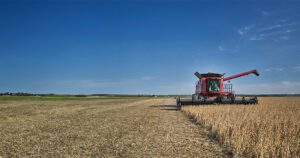By Paul Winters
The Sustainable Aviation Fuel Grand Challenge is a coordinated effort among multiple federal agencies to scale up production of SAF by midcentury. Renewable fuels like SAF are critical to reducing greenhouse gas emissions in sectors where alternative low-carbon options won’t be available in the foreseeable future.
The goal is to produce 35 billion gallons per year by 2050, with an interim milestone of 3 billion gallons by 2030. In 2022, SAF production for the U.S. market reached 15 million gallons, with roughly half produced in the United States. Reaching the 2030 goal would require doubling production every single year.
There are multiple technology and feedstock combinations for producing SAF. Significantly, the existing production (and most production planned for the near future) utilizes the hydrotreated esters and fatty acids (HEFA) pathway—a process similar to renewable diesel production. And while SAF is currently limited to blends with petroleum jet fuel between 5% and 50%, industry participants are working within the ASTM process to certify the HEFA pathway for 100% use in commercial jets.
Several U.S. companies, including World Energy and Diamond Green Diesel, have announced projects that could bring more than 700 million gallons of HEFA SAF capacity online by 2025. Growth of SAF will be tied to growth of the overall biodiesel and renewable diesel industry, including the U.S. agricultural feedstock markets that are partnering with them.
Pioneering SAF efforts are receiving significant policy support, including new tax incentives established by Congress. And the U.S. EPA has approved new feedstocks such as canola and fuel production facilities to participate in the Renewable Fuel Standard program. But significant challenges remain in policy implementation. EPA’s proposed Renewable Fuel Standard volumes for 2023, 2024 and 2025 present one potential roadblock: The agency is proposing very little growth in the RFS advanced biofuel pool over the next three years, undercounting both existing and anticipated production.
Renewable jet fuel projects to date are all approved to generate biomass-based diesel (BBD) D4 RINs, since they displace kerosene distillates. But EPA is proposing an increase of just 190 million gallons in the BBD volumes through 2025. EPA estimates that SAF volumes in the RFS will remain flat at 3.1 million gallons annually over the three-year period, stating, “Feedstock limitations are likely to cause any growth in renewable jet fuel to come at the expense of biodiesel and renewable diesel.”
Despite EPA’s low assessment, feedstock supplies are increasing. In 2022, the clean fuels industry generated 3.6 billion gallons of biodiesel, renewable diesel and SAF qualifying for D4 RINs using existing feedstocks. That represented a 500-million-gallon increase of over 2021, and the industry is set to expand capacity at a similar pace over the next few years. The U.S. soy industry has invested more than $4.75 billion to increase oilseed processing capacity by 33%, or roughly 650 million bushels to provide feedstocks to fuel that growth.
Sustainably grown agricultural feedstocks like soybean and canola are crucial to meet the SAF Grand Challenge, and to expand biodiesel and renewable diesel for other markets—such as rail and shipping—where alternative low-carbon options are not available. Many of the new renewable diesel and SAF facilities plan to use a combination of surplus vegetable oils, recycled cooking oil and animal fats.
Another concern is the U.S. Treasury Department’s implementation of the SAF tax incentive, which is tied to the carbon reductions measured over the fuel’s lifecycle. Treasury has no prior experience in measuring lifecycle carbon emissions. Congress directed Treasury to utilize either the International Civil Aviation Organization’s CORSIA or a similar model, such as Argonne National Lab’s GREET, to score SAF emissions and calculate the appropriate incentive.
Treasury must consistently use the GREET model for SAF, biodiesel and renewable diesel. The most recent GREET modeling incorporates data provided by U.S. renewable diesel producers from actual facility operation. The CORSIA model is built on an old version of the GREET model and uses outdated assumptions about international land use change that unfairly penalize U.S.-grown crops. The GREET model, by comparison, uses up-to-date information supplied by the U.S. industry to model both direct emissions tied to production technology and indirect emissions from feedstocks.
Excluding U.S.-grown crop oils from the tax incentives or the RFS—or from state low-carbon fuel programs—would undermine the goals of the SAF Grand Challenge. It would also short-circuit the critical carbon reduction goals of other industries. Clean Fuels Alliance America is taking a leading role in ensuring that these policies facilitate, rather than derail, the industry’s progress.
ABOUT CLEAN FUELS ALLIANCE AMERICA
Made from an increasingly diverse mix of resources such as recycled cooking oil, soybean oil, and animal fats, the clean fuels industry is a proven, integral part of America’s clean energy future. Clean Fuels Alliance America is the U.S. trade association representing the entire biodiesel, renewable diesel and sustainable aviation fuel supply chain, including producers, feedstock suppliers and fuel distributors. Clean Fuels receives funding from a broad mix of private companies and associations, including the United Soybean Board and state checkoff organizations.




